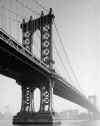 |
New York
Architecture Images-New York Bridges Manhattan Bridge |
||||||||||||||||||||||||||||
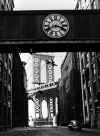 |
click here for Manhattan Bridge gallery | ||||||||||||||||||||||||||||
| Contemporary black and white images on this page copyright Dave Frieder ( www.davefrieder.com ). Special thanks to Dave Frieder for permission to use images. | |||||||||||||||||||||||||||||
|
architect |
Gustav Lindenthal,Nichols, Modjeski and Leon Moisseiff. (designed by Leon Moisseiff and O.H. Nichols was Chief Engineer. This was a 3rd design and the towers were similar to the 2nd design by Gustav Lindenthal. The 1st design was to have parallel wire cables. That was dropped and the 2nd design by Lindenthal was to have Eyebars instead. Then the 3rd design reverted back to parallel wire cables. That is the type of structure we have today. -Dave Frieder) | ||||||||||||||||||||||||||||
|
location |
East River between Canal Street, Manhattan and Flatbush Avenue, Brooklyn. | ||||||||||||||||||||||||||||
|
date |
1901-9 | ||||||||||||||||||||||||||||
|
style |
Structural Expressionism | ||||||||||||||||||||||||||||
|
construction |
steel | ||||||||||||||||||||||||||||
|
type |
Suspension Bridge | ||||||||||||||||||||||||||||
|
data |
|
||||||||||||||||||||||||||||
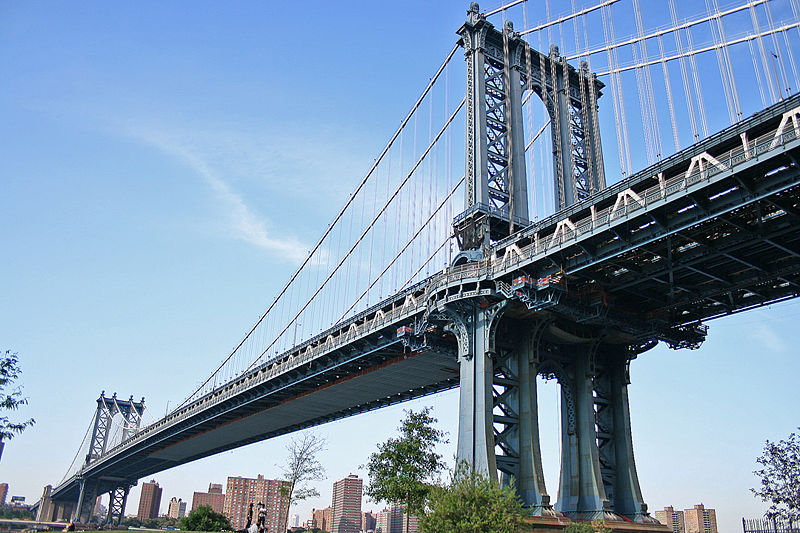 |
|||||||||||||||||||||||||||||
| As seen from Brooklyn | |||||||||||||||||||||||||||||
.jpg) |
|||||||||||||||||||||||||||||
| The Manhattan Bridge under construction in March of 1909 | |||||||||||||||||||||||||||||
.jpg) |
|||||||||||||||||||||||||||||
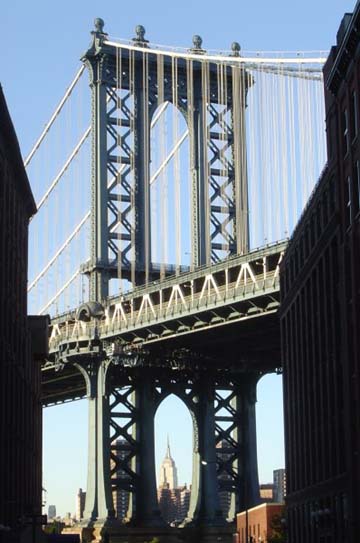 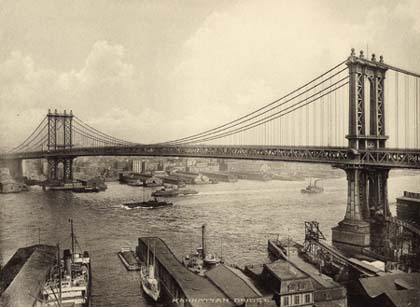 |
|||||||||||||||||||||||||||||
|
|
 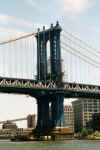 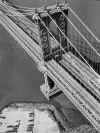   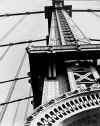 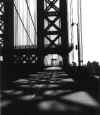  |
||||||||||||||||||||||||||||
| Dave Frieder Gallery. Copyright Dave Frieder ( www.davefrieder.com ) | |||||||||||||||||||||||||||||
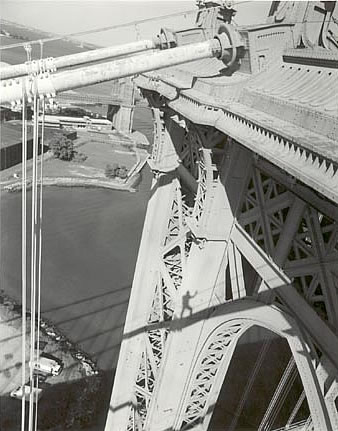
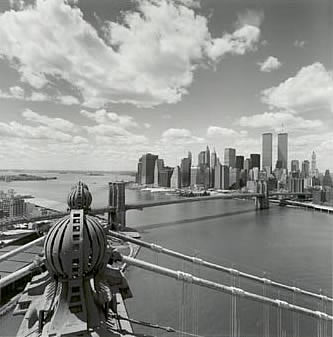 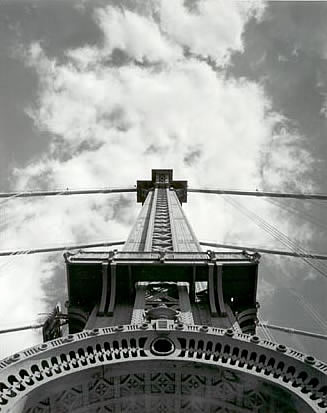
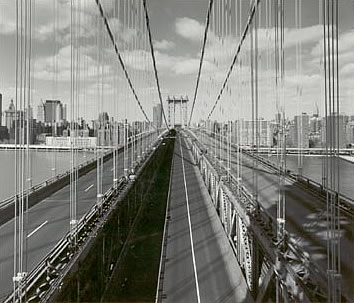 |
|||||||||||||||||||||||||||||
 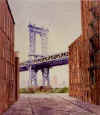     |
|||||||||||||||||||||||||||||
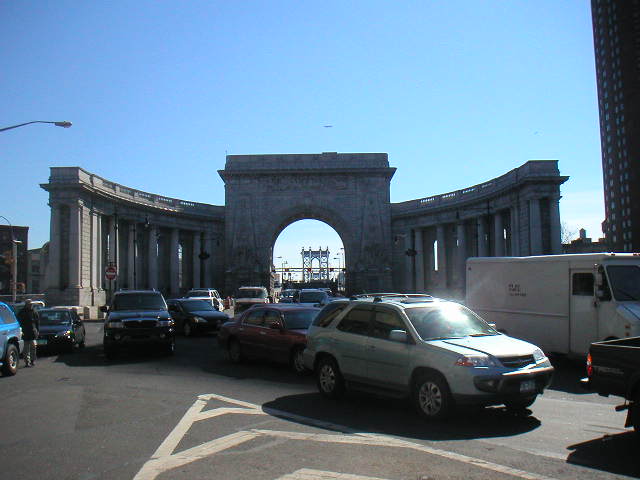 |
|||||||||||||||||||||||||||||
 |
|||||||||||||||||||||||||||||
|
The Manhattan Bridge is a suspension bridge that crosses the East River in
New York City, connecting Lower Manhattan (at Canal Street) with
Brooklyn (at Flatbush Avenue Extension). It was the last of the three
suspension bridges built across the lower East River, following the
Brooklyn and the Williamsburg bridges. The bridge was opened to traffic
on December 31, 1909 and was designed and built by Polish bridge
engineer Ralph Modjeski with the deflection cables designed by Leon
Moisseiff, who later designed the infamous Tacoma Narrows Bridge in
1940. It has 4 vehicle lanes on the upper level (split between two
roadways), and 3 vehicle lanes, 4 subway tracks, a walkway and a bikeway
on the lower level. The upper level, originally used for streetcars, has
2 lanes in each direction, and the lower level can be one-way in peak
direction or have 2 lanes in one direction and the other in the opposite
direction. It once carried New York State Route 27 and later was planned
to carry Interstate 478. No tolls are charged for motor vehicles to use
Manhattan Bridge. The original pedestrian walkway on the south side of the bridge was reopened after sixty years in June 2001. It was also used by bicycles until late summer 2004, when a dedicated bicycle path was opened on the north side of the bridge, and again in 2007 while the bike lane was used for truck access during repairs to the lower motor roadway. The bridge and I-478 As part of the construction of the Lower Manhattan Expressway, there were plans to make the Manhattan Bridge Interstate 478 but since this interstate would have led to a crosstown expressway and the existing Brooklyn-Queens Expressway, the FHWA said that the first digit should be even so I-478 was chosen.[1] However, with the cancellation of I-78 through New York City, the spur was dubbed useless. Manhattan Bridge in film The Bridge is featured prominently in director Sergio Leone's gangster epic Once Upon a Time in America. In The Cowboy Way, the two main cowboy characters chase a B train over the bridge to rescue a friend in grave danger. The alien spacecraft that destroys New York in Independence Day makes its entrance over the Manhattan Bridge. The bridge is featured prominently in director Peter Jackson's 2005 remake of King Kong. In the 1930s period a very steep, simple ramp is used by automobiles to access the Bridge in contrast to today's integrated gradual ramp system into the surrounding roadways. The bridge is featured in an action traffic scene in the 1973 James Bond film Live and Let Die along the East River Drive when James Bond's CIA driver is assassinated by the villain Whisper in a pimpmobile and Bond has to steer the car through dangerous New York traffic. The bridge plays a large role in the 1984 Steve Martin romantic comedy film The Lonely Guy, in which it is a popular spot for Lonely Guys to commit suicide, and the meeting place for Steve Martin and Judith Ivey. In Aftershock: Earthquake in New York, a WCBS-TV helicopter flies above the East River after an earthquake strikes New York City. Both the Brooklyn and Manhattan Bridges are destroyed. * 2007's I Am Legend shows the Brooklyn and Manhattan Bridges with their center spans destroyed. A flashback reveals they were hit by missiles to stop the exodus from a quarantined Manhattan. |
|||||||||||||||||||||||||||||
|
Built between 1901 - 1909, this 6,855 foot long suspension bridge connects Manhattan with the Borough of Brooklyn. Like the other three East River Bridges, it provides access to pedestrians, bicyclists, automobiles and it's one of three Manhattan bridges to carry trains....In this case it's the B, D & Q lines. I've read about how this is considered to be one of the more attractive bridges in the city. There's an ongoing plan to expand on it's existing pedestiran and bike paths, and complete repair by 2008. It's estimated that more than 78,000 vehicles crossed the bridge on your average 1998 day....The bridge's ends are at: Chinatown's Canal Street in Manhattan and Flatbush Ave in Brooklyn. PS...Did you know this is the strongest of the 4 east river crossings? Should you wish to learn more about this
bridge read the
stats
section below or you could visit: Built of steel, this
two-level suspension bridge is often mistakenly attributed to Gustav
Lindenthal, who submitted a plan for the bridge in 1903 that was
rejected by city leaders for its structural innovations. PLANNING "SUSPENSION BRIDGE NUMBER 3": The Manhattan Bridge was first planned as a traditional wire-cable suspension bridge to be used exclusively by trains. In 1892, elevated railway magnate Frederick Uhlmann proposed this span just north of the present site of the Manhattan Bridge. The bridge was planned in conjunction with another one of his proposals, the Williamsburg Bridge. While Uhlmann's railroad bridge was never constructed, the Williamsburg Bridge was approved in 1895 to handle mixed traffic. In 1901, Gustav
Lindenthal, the commissioner of the newly created New York City
Department of Bridges, presented plans for the proposed Manhattan Bridge
(originally called "Suspension Bridge Number 3"), which was to connect
the Bowery and Canal Street in Chinatown with Flatbush Avenue in
downtown Brooklyn. He selected R.S. Buck as the chief engineer of the
project. While he was no relation to Leffert L. Buck, the chief engineer
on the Williamsburg Bridge project, R.S. Buck worked with him as an
assistant on other projects. The project, which had the support of Mayor
Seth Low, got underway on October 1, 1901.
|
|||||||||||||||||||||||||||||